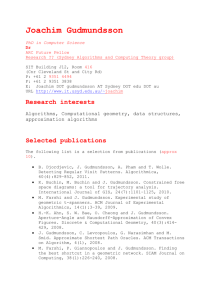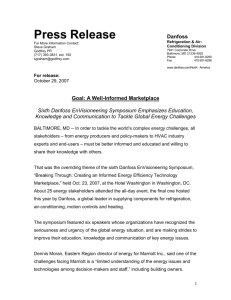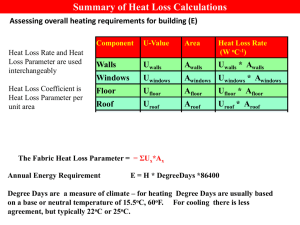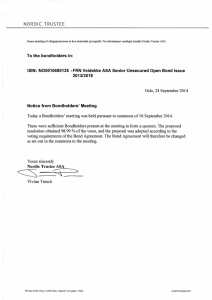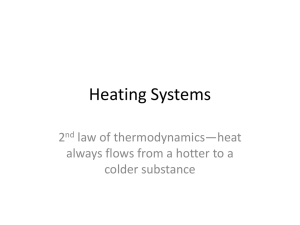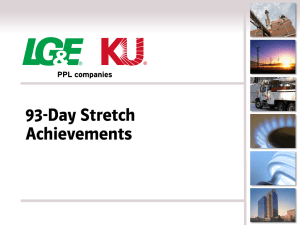Utilization of return water in district heating networks
advertisement
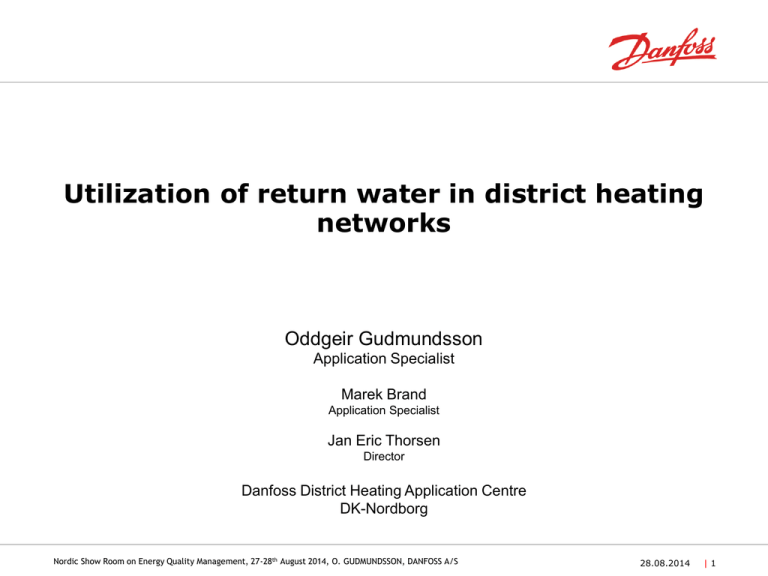
Utilization of return water in district heating networks Oddgeir Gudmundsson Application Specialist Marek Brand Application Specialist Jan Eric Thorsen Director Danfoss District Heating Application Centre DK-Nordborg Nordic Show Room on Energy Quality Management, 27-28th August 2014, O. GUDMUNDSSON, DANFOSS A/S 28.08.2014 |1 Content Introduction Concept Technology Cases Conclusion Nordic Show Room on Energy Quality Management, 27-28th August 2014, O. GUDMUNDSSON, DANFOSS A/S 28.08.2014 |2 Introduction 1G 2G Nordic Show Room on Energy Quality Management, 27-28th August 2014, O. GUDMUNDSSON, DANFOSS A/S 3G 4G 28.08.2014 |4 Concept District heating schemes are operating with various temperature levels depending on the original design of the network and the connected building stock In many cases existing buildings may require high supply temperatures and consequently have high return temperatures, f.ex. supply of 90-100°C and return of 40-60°C Sufficient temperature levels vary and depend on the heating installations New energy efficient buildings with floor heating installation only need supply temperatures of 35-40°C to fulfill their heating requirement Domestic hot water (DHW) temperature of 45°C is considered sufficient for everyday use. Having DH supply temperature of 50°C is sufficient for preparing DHW at 45°C via instantaneous heat exchanger solution, without risk of Legionella. This fact gives the opportunity to utilize the return flow from existing areas in new areas and hence utilize the capacity of existing DH networks to a greater extend with minimum investment costs. Utilize further the capacity of the distribution network Increased efficiency at the plant due to lower return temperature Reduced heat losses in the return line Nordic Show Room on Energy Quality Management, 27-28th August 2014, O. GUDMUNDSSON, DANFOSS A/S 28.08.2014 |5 Conceptual example of cascading energy usage in district heating Non-renovated older buildings All energy classes Low-energy buildings Large scale solar multi-apartment single-family CHP natural gas Recently build and renovated Newly constructed / renovated areas High temperature supply, 90°C CHP waste incineration Nordic Show Room on Energy Quality Management, 27-28th August 2014, O. GUDMUNDSSON, DANFOSS A/S High temperature return, 50°C Low temperature return, 25°C 28.08.2014 |6 Utilization of return water for existing buildings Renovation of the existing network Low Temperature District Heating Nordic Show Room on Energy Quality Management, 27-28th August 2014, O. GUDMUNDSSON, DANFOSS A/S 28.08.2014 |7 Low Temperature DH for existing buildings Project supported by the Danish government 75 single-family buildings from 1997 Floor heating Realisation New low-temperature DH in-house substation New DH network Heat loss reduced from 41% -> 14% 80% of heat demand supplied from main DH return line Before transition average Tsupply = 70-75°C After transition average Tsupply = 55°C Nordic Show Room on Energy Quality Management, 27-28th August 2014, O. GUDMUNDSSON, DANFOSS A/S 28.08.2014 |8 Area substation As the DH return temperature can vary it may become necessary to raise the return temperature before it is supplied to the secondary network This can be achieved by mixing the return water with hot water from the main DH supply pipeline Primary network Sønderby Area substation Tsupply=90°C Treturn=52°C Treturn=26°C Nordic Show Room on Energy Quality Management, 27-28th August 2014, O. GUDMUNDSSON, DANFOSS A/S Sønderby low temperature DH Sønderby Last consumer Tsupply=52°C Substation at the consumer Thermostatic bypass 28.08.2014 |9 Nordic Show Room on Energy Quality Management, 27-28th August 2014, O. GUDMUNDSSON, DANFOSS A/S 28.08.2014 | 10 Micro booster – Reduced temperature levels Ultra-Low Temperature District Heating Nordic Show Room on Energy Quality Management, 27-28th August 2014, O. GUDMUNDSSON, DANFOSS A/S 28.08.2014 | 11 Objective: Maximum utilization of district heating return flow Area substation Ultra-Low Temperature DH for existing buildings Project supported by the Danish government 4 single-family buildings from before 1960 Radiators, mix of 1 pipe and 2 pipe systems Realization Micro heat pump DH substation in each house to boost the supply temperature for instantaneous preparation of Domestic Hot Water New U-LTDH network Heat loss only 46% of the heat loss that would be experienced in a traditionally designed network Area heat exchanger substation connected to the main district heating network regulates the supply temperature Supply temperature kept as low as possible at all times Nordic Show Room on Energy Quality Management, 27-28th August 2014, O. GUDMUNDSSON, DANFOSS A/S 28.08.2014 | 12 Micro booster concept For floor heating temperature levels of 30-40°C are sufficient Domestic hot water of 45°C is sufficient for all normal use Micro booster installed With instantaneous preparation of DHW there is no risk of Legionella Micro heat pump unit boost the supply temperature to 53-55°C and stores the water in a primary side located storage tank until DHW tapping occurs Condenser Evaporator DH side storage tank Instantaneous DHW preparation No Legionella risk Nordic Show Room on Energy Quality Management, 27-28th August 2014, O. GUDMUNDSSON, DANFOSS A/S 28.08.2014 | 13 Heat exchanger area substation The aim of the substation is to maintain constant secondary side temperature of 40°C As the DH return temperature can vary primary side supply is mixed with the return to maintain constant 45°C supply to the heat exchanger by means of a pump control Nordic Show Room on Energy Quality Management, 27-28th August 2014, O. GUDMUNDSSON, DANFOSS A/S 28.08.2014 | 14 How applicable can this be? Nordic Show Room on Energy Quality Management, 27-28th August 2014, O. GUDMUNDSSON, DANFOSS A/S 28.08.2014 | 16 Low-temperature DH for existing buildings Supported by the Danish government 8 single-family houses from 1970 With traditional radiators: 70/40/20°C How much could Tsupply be reduced without sacrificing comfort? 70°C 40°C heat output 100 % same radiators ṁ = constant 50°C 33°C heat output 55 % Numerical simulations Real measurements Many possibilities Should follow real conditions Various refurbishment stages Results are coming soon… Low-temperature radiators Nordic Show Room on Energy Quality Management, 27-28th August 2014, O. GUDMUNDSSON, DANFOSS A/S 28.08.2014 | 17 Single-family-house from 1970 – results from simulation Heating curves for radiators Duration of Tsup over/equal certain temperature Tsupply [°C] hours above certain temperature [%/a] 25 20 15 10 5 0 >55 >60 >65 >70 21.4 8.1 2.9 1.3 0.2 66.1 new windows 20°C 6.8 1.8 0.2 0.0 0.0 91.1 extensive renovation 20°C 0.4 0.0 0.0 0.0 0.0 99.6 new windows 22°C 16.5 4.8 1.6 0.1 0.0 77.0 new windows 22°C LT rad. 1.8 0.3 0.0 0.0 0.0 97.9 non-renovated 20°C ! Low-temperature substation for DHW ! =50 >50 Tsupply [°C] *Extensive renovation = low energy windows + roof insulation Nordic Show Room on Energy Quality Management, 27-28th August 2014, O. GUDMUNDSSON, DANFOSS A/S 28.08.2014 | 18 LTDH for Existing Buildings Existing buildings can be supplied with LTDH already today if Tsupply is in cold periods increased above 50°C Required Tsupply to radiators depends on: desired indoor temperature state of the building heating system DH companies should be more strict in reducing Tsupply to: reduce heat losses from DH network integrate more renewables DHW applicatoin should always be changed to lowtemperature one Nordic Show Room on Energy Quality Management, 27-28th August 2014, O. GUDMUNDSSON, DANFOSS A/S 28.08.2014 | 19 Conclusions There is a potential to further utilize the capacity of existing district heating network and reduce the network return temperature significantly by cascading the energy use Studies show that with light renovation of buildings the requirements to the DH supply temperature sinks significantly As new areas are built or building areas renovated close to existing district heating network it is possible to establish district heating network with low investment costs utilizing the remaining heat in the return pipeline from the existing DH grid Nordic Show Room on Energy Quality Management, 27-28th August 2014, O. GUDMUNDSSON, DANFOSS A/S 28.08.2014 | 20 Thank you for the attention Contact information: Oddgeir Gudmundsson Application Specialist, Application Centre Danfoss District Energy, DK-Nordborg og@danfoss.com Nordic Show Room on Energy Quality Management, 27-28th August 2014, O. GUDMUNDSSON, DANFOSS A/S 28.08.2014 | 21
